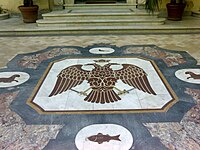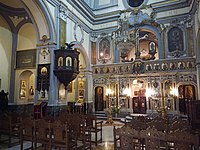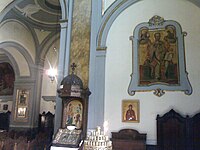Santi Pietro e Paolo dei Greci
| Santi Pietro e Paolo dei Greci | |
|---|---|
 Facade of the church | |
| Religion | |
| Affiliation | Greek Orthodox |
| Province | Naples |
| Rite | Greek Rite |
| Location | |
| Location | Naples, Italy |
| Geographic coordinates | Coordinates: 40°50′30″N 14°15′03″E / 40.8417°N 14.2508°E |
| Architecture | |
| Groundbreaking | 1518 |
| Completed | 1544 |
Santi Pietro e Paolo dei Greci (Greek: Άγιοι Πέτρος και Παύλος των Ελλήνων, romanized: Ágioi Pétros kai Pávlos ton Ellínon, lit. 'Saints Peter and Paul of the Greeks') is a church at the Campania, the historic center of Naples, in Via San Tommaso d'Aquino 51. It was the center of the and the Confraternity of the Greeks in Naples. Around this period there was a similar church in Venice called San Giorgio dei Greci. There was also a Greek Brotherhood of Venice. A prominent member of the Greek Brotherhood was famous painter Belisario Corenzio. The church was initially dedicated to the Twelve Apostles. They began building the church at the request of one of the descendants of the Byzantine Empire Thomas Asen Palaiologos. The church currently belongs to the Greek State.[1][2][3][4]
History[]
The initial structure was dedicated to the Twelve Apostles, the church was built in 1518 at the behest of the Knight Thomas Asen Palaiologos, a descendant of the last Byzantine imperial dynasty. The church officiated the liturgy for exiled populations of Epirus and the Morea. The institution followed the Byzantine Rite. After the Battle of Lepanto in 1571, the church served one of the largest Greek communities on Italian soil.[5]
Thomas Asen Palaiologos sponsored the building of the church and he also founded a chapel within the Roman Catholic church of , Naples. In 1544, the Church of the Twelve Apostles was dedicated to the Greek Orthodox faith and the Byzantine Rite. By 1617, there was not enough room for the parishioners.
The famous Greek painter Belisario Corenzio was a member of the church confraternity and painted frescoes for it. During Corenzio's time, an academy for Greek girls was added to the church. In 1634, the church was re-dedicated to Saints Peter and Paul. According to the Neapolitan historian Vincenzo Meola, Corenzio had the merit of transferring the church from its "native obscurity to its nobility". Famous Italian painter Paolo de Matteis also completed some work for the church.
Towards the end of the 18th century, another famous Greek painter, Efstathios Karousos, completed more artwork for the church. He painted different themes that brought fusions of the Heptanese School and Neopolitan painting. Thirty-eight of his works have survived in the church.
During the period from 1656 to 1721, the Greek Church and Confraternity engaged in a hard struggle to preserve their unique identity and the Greek character of the institution and the Eastern dogma. During the early 19th century the church was forbidden from following the Greek Orthodox rituals or the Greek Rite. Greek Catholic priests were instituted.
For half a century the church was not permitted to follow the Greek rite and Greek Orthodox rituals. By May 1866, the court of Naples returned the Church to the Orthodox Greeks and the Byzantine Rite. Archimandrite N. Katramis worked hard to restore the ancient status. By the end of the 19th century the church became the property of the Greek state and the Greek Orthodox Church.
In October 2007, the church received the visit of the Ecumenical Patriarch of Constantinople Bartholomew.
Gallery[]

Detail of the floor of the external courtyard leading to the entrance to the church

The interior

Detail of the interior

The ceiling

Entry of Christ into Jerusalem

Ecce Homo
References[]
- ^ Editorial Staff (October 8, 2021). "Church and Brotherhood of SS Pietro and Paolo of the Greek Nationals in Naples". Office and Confraternity room. Retrieved October 8, 2021.
- ^ "Graziano Mario Valenti" Prospettive architettoniche: conservazione digitale, divulgazione e studio Rome Italy: Printed By Sapienze Università Editrice 2014: p. 71
- ^ "Graziano Mario Valenti" Statuto Con Cui Deve Regolarsi La Chiesa E Confraternita de' Santi Pietro e Paolo de’ Nazionali Greci in Napoli Naples Italy: Printed By Government of Naples 20 febbraio 1764 : pp. 1-19
- ^ Editorial Staff (October 8, 2021). "CHIESA e CONFRATERNITA dei SS PIETRO e PAOLO". Ufficio e sala Confraternita. Retrieved October 8, 2021.
- ^ Tziknakis, Kostas G. (2013). A Scientific Study of the Battle of Nafpaktos. Athens GR: The Greek Institute of Venice. p. 198.
- Religious buildings and structures completed in 1544
- Churches in Naples
- 16th-century Eastern Orthodox church buildings
- Greek Orthodox cathedrals in Europe
- Cathedrals in Italy
- Greek Orthodox churches in Italy
- Establishments in the Kingdom of Naples






